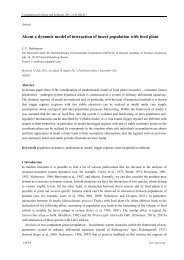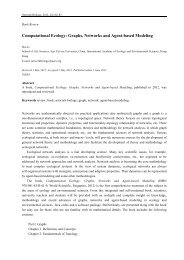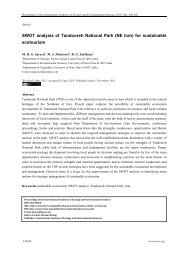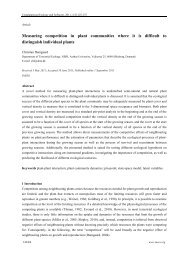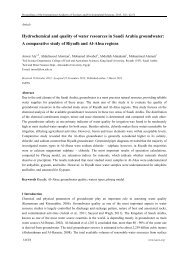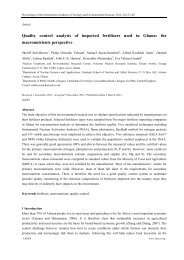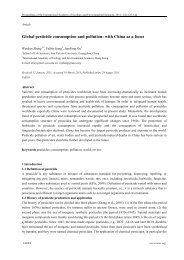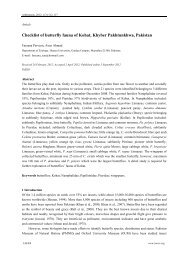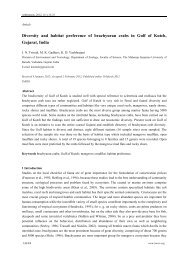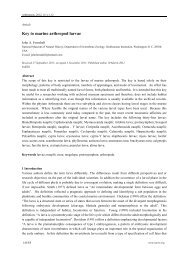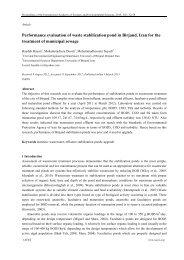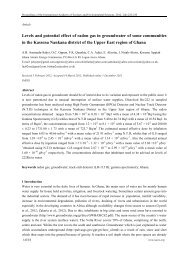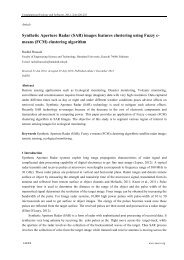Invasion ecology: Origin and biodiversity effects - JournalTOCs
Invasion ecology: Origin and biodiversity effects - JournalTOCs
Invasion ecology: Origin and biodiversity effects - JournalTOCs
You also want an ePaper? Increase the reach of your titles
YUMPU automatically turns print PDFs into web optimized ePapers that Google loves.
Environmental Skeptics <strong>and</strong> Critics, 2013, 2(3): 73-81<br />
77<br />
competitive release, (3) resource availability, <strong>and</strong> (4) propagule pressure. But also widely recognized is the<br />
“fluctuating resource theory of invasibility” (Davis et al., 2000).<br />
Another term, also primarily devoted to plant invasions but with some marine animal examples, is<br />
“facilitation “(Stachowicz, 2001; Bruno et al., 2003). Facilitation has been defined as direct positive<br />
interactions between two organisms that benefit at least one. This definition includes commensalisms <strong>and</strong><br />
mutualisms as well as mutually obligate <strong>and</strong> facultative relationships. In plant communities, facilitation may<br />
alternate with competition in response to environmental change (Callaway <strong>and</strong> Walker, 1997). A review of the<br />
literature on biotic interactions (Bruno et al., 2005) suggested that direct facilitative interactions are at least as<br />
common <strong>and</strong> as important as competition <strong>and</strong> predation in structuring communities. Richardson et al. (2000)<br />
argued that a key lesson in invasion <strong>ecology</strong> was that facilitation by numerous resident species was often<br />
required for successful colonization. But some authors (Munguia et al., 2009) believe that facilitation is not a<br />
true species interaction because the fitness of one of the species involved remains unaffected.<br />
The term “accommodation” was initially proposed to characterize colonizing invasions in the marine<br />
environment (Briggs, 2010). Accommodation means the yielding of living space, indicating that whatever<br />
native species occupies the preferred space, it will give way to or support the invader permitting both species<br />
to become established in a location where only one existed previously. Compared to facilitation,<br />
accommodation is the broader term because it includes facilitation, as well the competition that is perceived<br />
when the native species is apparently forced to give way to or physically support the intruder. So, successful<br />
invasions can be said to be driven by dispersal (human or natural), discovery of suitable locations, <strong>and</strong><br />
accommodation by native organisms. Sometimes, the critical factor may be substrate suitability (invasibility)<br />
or facilitation, but when the details of the species relationships are unknown, as is often the case,<br />
accommodation (as the more inclusive term) may be employed. Finally, it may be noted that both invader<br />
species <strong>and</strong> exp<strong>and</strong>ing native species are accommodated when they move into new ecosystems, but no<br />
differences in acceptance between the two have been reported.<br />
Another factor, also first noted in regard to the marine environment, was the existence of fossil data<br />
indicating that historical invasions had resulted in significant increases in speciation over millions of years.<br />
Thus at least some of the local diversity increases produced by the invasions were eventually converted into<br />
global increases. Similar information is available in regard to historical plant invasions. The classic paper by<br />
Lidgard <strong>and</strong> Crane (1990) <strong>and</strong> a more recent study by Magallon <strong>and</strong> Castillo (2009) traced the rise in<br />
angiosperm species diversity through the Cretaceous. Angiosperm plants first appeared in equatorial regions<br />
about 140 million years ago (Ma). About 90 Ma, angiosperms invaded the higher latitudes <strong>and</strong> gradually<br />
became the dominant type of vegetation while the cycads, ferns, <strong>and</strong> conifers declined. The enormous gains in<br />
angiosperm species diversity that took place following their high latitude dispersal, indicated that their<br />
invasions had lasting benefits in terms of an increases in global <strong>biodiversity</strong>.<br />
6 Extinctions<br />
Aside from cases on oceanic isl<strong>and</strong>s, freshwater lakes <strong>and</strong> streams, <strong>and</strong> other similarly restricted habitats, there<br />
appears to be a virtual absence of invasion caused extinctions (Gurevitch <strong>and</strong> Padilla, 2004). In cases involving<br />
marine organisms, l<strong>and</strong> plants, <strong>and</strong> smaller terrestrial animals, evidence for invasion caused extinctions is<br />
weak or nonexistent, except on isl<strong>and</strong>s (Vermeij, 2005). There is no evidence that competition from exotic<br />
plants has caused any native species extinctions (Davis, 2003) <strong>and</strong>, even on isl<strong>and</strong>s, plant <strong>and</strong> animal<br />
extinctions are primarily caused by predation rather than competition (Sax <strong>and</strong> Gaines, 2008). In the marine<br />
environment there have been no cases of native extinction resulting from competition by exotic species (Sagoff,<br />
2005; Briggs, 2007, 2012). In fact, there have been very few contemporary, marine extinctions from any cause.<br />
IAEES<br />
www.iaees.org



